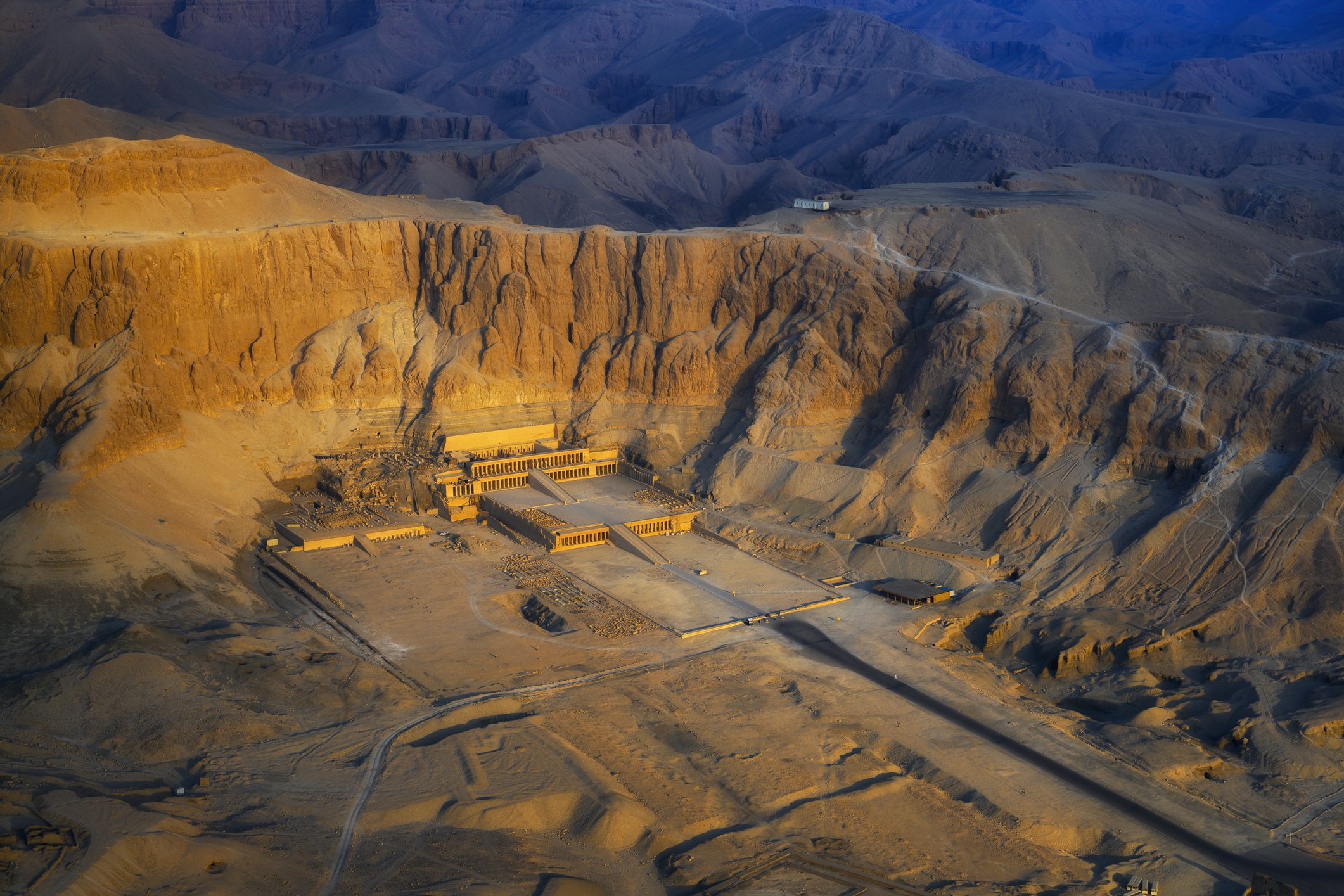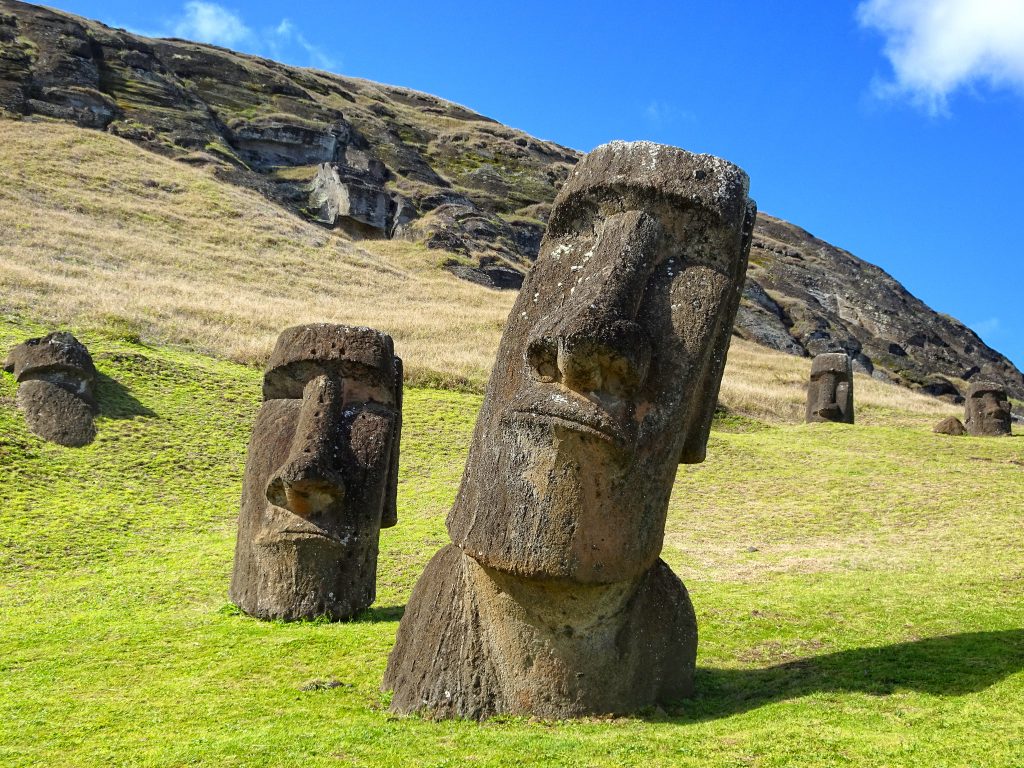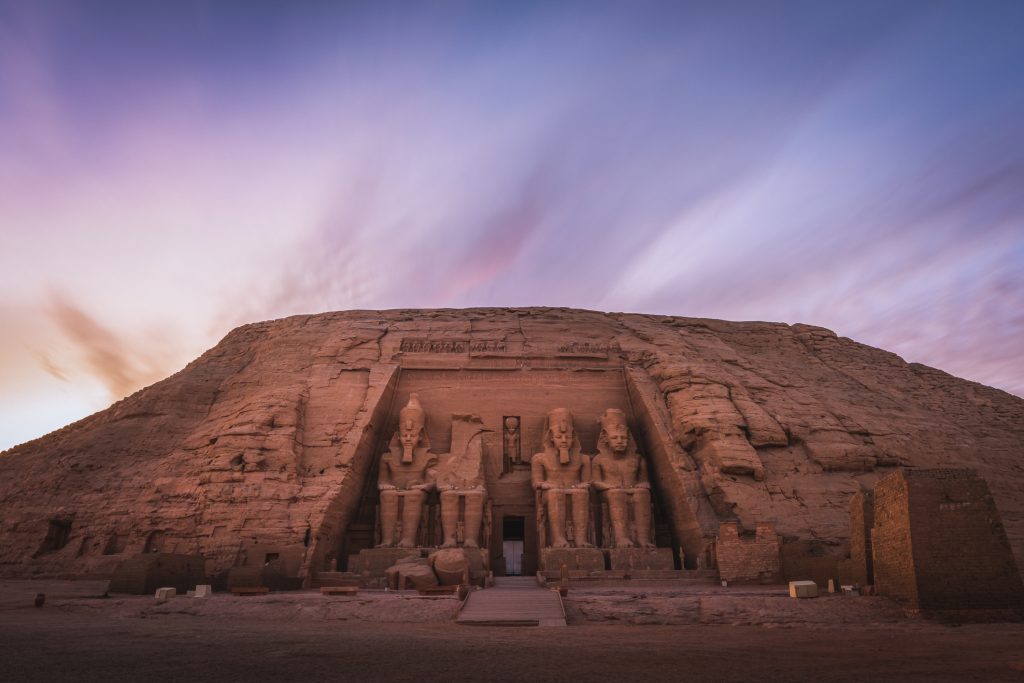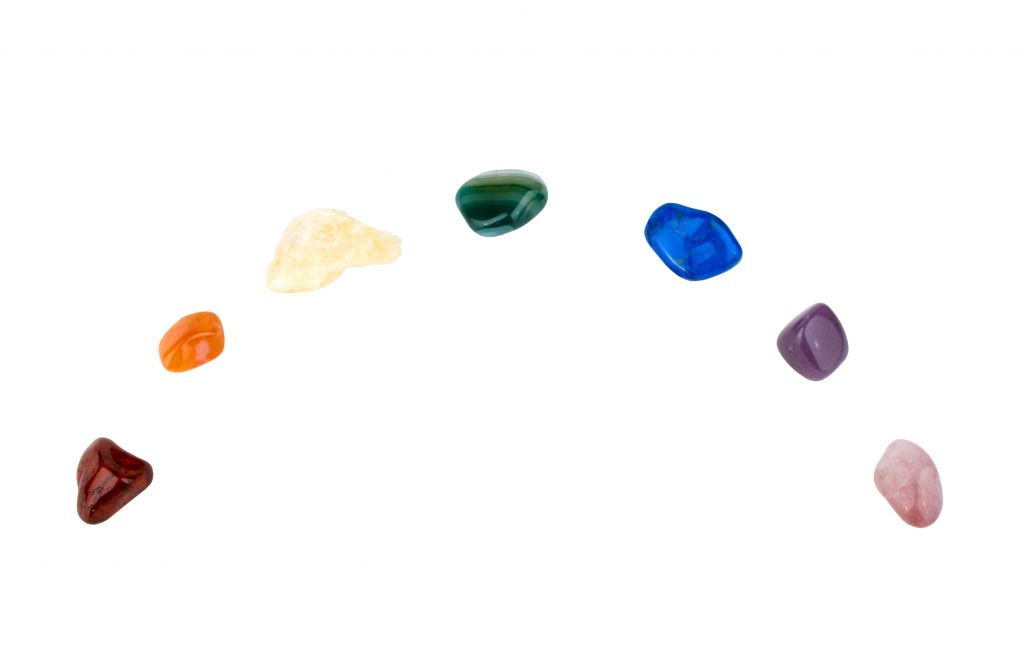As one of Egypt’s first female rulers, Queen Hatshepsut truly had a unique legacy within human history. In order to honor this, she commissioned the construction of a mortuary truly befitting of a great ruler.
With a reign marked by peace and prosperity and a final resting place possessing an undeniably great visage, Hatshepsut was all but destined to be immortalized among the great pharaohs of Egypt.
Queen Hatshepsut’s story isn’t that straight forward.
Her accomplishments and legacy were close to being lost in the sands of time. Were it not for the relentless pursuit of scholars, the Hatshepsut Temple could have remained hidden and buried forever.
Why would the Egyptian people want to wipe the Hatshepsut Temple from the history books?
Let’s explore the full story.
Where is the Hatshepsut Temple?

Image: A side on aerial view of the stunning Hatshepsut Temple. Source
Located on the western bank of the Nile (or in Western Thebes, the great capital of Egypt during the New Kingdom), this is one of the most beautiful Egyptian burial tombs.
The terraces were different then, with gardens of frankincense trees and other rare plantings brought from Punt, a place that appears in painted reliefs decorating the walls of one of the colonnades.
How to get to the Hatshepsut Temple

Image: A front on aeriel view of the temple.
One of the best ways to arrive at Hatshepsut is walking from the Valley of the Kings over the mountain pass. Few people know of and use the trail. The half hour walk is well worth the effort and the views on the final approach are superb. Looking down on the Temple below, the people look tiny, like swarming ants.
Arriving in this way, you are able to see how the Hatshepsut Temple is built into the rock cliffs that tower above. You see the surrounding area of the west bank of the Nile.
Go prepared, wearing walking footwear with good support. Also take plenty of water as it can get hot. A hat, sun glasses and sun screen are suggested.
The History of the Hatshepsut Temple
Hatshepsut (1479-1458 BCE) was the eldest daughter of Thutmose I and his Great Wife, Ahmose. As part of the standard practice of Egyptian royalty, she was married to her half-brother, Thutmose II, and achieved the rank of God’s Wife of Amun. In those times, that was the highest attainable honor for an Egyptian woman after the rank of Queen.
When Thutmose II died, his son with his lesser wife Isis (named Thutmose III) was still a child. Thus, Hatshepsut became the queen, meant to hold the position and make decisions until Thutmose III came of age.
Things took a different turn, though, when Hatshepsut decided that she could do the job just as well as any man could. Thus, she had herself crowned the Pharaoh of Egypt, ruling over the nation for over 20 years.
As it turned out, Hatshepsut was correct. Based on historical records, Hatshepsut’s reign was characterized as a peaceful and prosperous one, with a healthy economy and trade relations, a decent employment rate, and numerous projects for public works to enhance Egyptians’ quality of life. On top of that, she made sure that their military forces were at peak performance and ever-prepared for war.
Hatshepsut did everything in her power to make her reign successful — to ensure that her legacy would be worth preserving. And she certainly didn’t waste time making sure that it would get preserved, even long after she was gone.
From Amun to Mentuhotep: The Temple’s Mythology

Image: Queen Hatshepsut was one of the first female rulers of Egypt. Source
Among the typical misconceptions about ancient Egypt is the depiction of Egyptian slave drivers forcing Hebrew slaves to build temples, pyramids, and other great structures.
However, experts say that the labor force at the time was actually comprised of Egyptian workers, both skilled and unskilled, who were paid a day’s wage. In other words, the incredible landmarks left behind by the ancient Egyptians were built with Egyptian hands working together.
To preserve her good name and accomplishments, Hatshepsut had her final resting place made by her workers at Deir el-Bahri, located on the west bank of the Nile river. She instructed them to model the mortuary temple after the one that belonged to Mentuhotep II, the founder of the 11th Dynasty and initiator of the Middle Kingdom of Egypt. Mentuhotep’s temple bore the look and feel that Hatshepsut was aiming for, but the queen wasn’t interested in copying it. Instead, she wanted it to be bigger and grander.
Hatshepsut’s aim was less about honoring someone else, though, and more about raising her own profile and beefing up her accomplishments. She knew that she had to work hard at preserving her legacy, given her status as a woman leader; making her final resting temple much bigger and more beautiful than anything anyone had ever seen before was pretty high on the list.
An Egyptian Temple of High Design

Image: A pillar inside the temple representing Queen Hapshepsut herself.
The commission of the temple occurred briefly after she assumed the role of pharaoh in 1479 BCE. True to Hatshepsut’s specifications, her steward and possible lover Senenmut made sure to mirror each aspect of Mentuhotep II’s temple. Hers would be on a grander, more elegant scale.
From the stone ramp to the archways, from the statues of lions by the entrance to the paintings that adorn the temple’s walls, Hatshepsut’s temple made everything bigger and better.
Without a doubt, Hatshepsut went to great lengths to prove her status as the rightful ruler of Egypt and legitimize her claim to the throne. One of the steps she took was to propagate the story of her divine creation, which portrays Amun or Ammon, the so-called King of the Gods, as her real father.
An Archaeological and Astronomical Wonder
Aside from depicting the myth of her divine conception, the temple also represented a few key departures from the prevailing design standards at the time.
It is said that Hatshepsut’s temple was the closest attempt at classical architecture ever accomplished by an Egyptian structure. Highlighting her accomplishments while paying tribute to the gods, Hatshepsut’s temple featured linear axiality, making it truly a sight to behold.
Interestingly, the temple’s main and axis were designed to align to the winter solstice sunrise. The builders also made it so that sunlight would be able to penetrate the innermost chamber via a lightbox within 41 days on either side of the solstice.
They designed the rear wall of the chapel so that when the sun’s rays pierced through it, they would highlight the Osiris statues along the entrance to the second chamber. The temple also had another lightbox that was designed to project the sunlight from a statue of Ammon to Thutmose III’s kneeling form to the depiction of Hapi, the god of the Nile.
The controversy of Hatshepsut and Thutmose III
As the stepmother of Thutmose, no one quite knows why she usurped Thutmose’s reign. While she reigned for 20 peaceful years, it appears there was an air of bitterness for the replaced boy pharoah.
While Hatshepsut led Egypt, her stepson Thutmose III was leading their armies. Appointed by the Queen as the military’s supreme commander, Thutmose III would go down in history as one of Egypt’s greatest military leaders.
However, after Thutmose III’s victory at the Battle of Megiddo in 1457 BCE, something strange happened. All of a sudden, Hatshepsut’s name was seemingly expunged from Egypt’s history, and all of her accomplishments as queen were attributed to Thutmose III, who had the records doctored to show that he became pharaoh after his father’s death, not Hatshepsut.
This was a peculiar development, as there seems to be no record of any estrangement or animosity between Thutmose III and his stepmother. Historians suggest that this may have been an attempt on Thutmose III’s part to erase the notion that a woman became pharaoh and was actually successful at it.
According to them, this may have been prompted by his desire to maintain the longstanding tradition of male Egyptian rulers, which Hatshepsut’s ascension to power broke.
Hatshepset Removed From the Egyptian History
Aside from striking her name from historical records, Thutmose III also had Hatshepsut’s monuments destroyed and dumped near her temple.
Based on ancient Egyptian beliefs, though, a person must be remembered here on the physical plane for them to be able to continue their journey in the afterlife.
Thus, this was a serious blow not just to Hatshepsut’s legacy, but also to whatever was waiting for her beyond life, according to Egyptian society’s tenets. (As Hatshepsut was not buried in her temple but in the Valley of the Kings, the circumstances of her death — an abscess after a tooth extraction gone wrong — would only be brought to light long after the discovery of her forgotten temple; in 2006 CE, to be precise.)
A Temple Rediscovered, A Legacy Restored
It would take centuries before Hatshepsut’s name and legacy would get unearthed from the sands of time. In the mid-19th century CE, the destroyed statues were found. However, nobody knew how to read hieroglyphics at the time, meaning that Hatshepsut’s name would remain in obscurity for a bit longer.
Eventually, the efforts of numerous scholars paid off, and they discovered that the hieroglyphics were actually pictorial representations of words. A French scholar named Jean-Francois Champollion would later realize that the temple actually contained references to a female ruler, which did not match Egyptian historical records.
Now that her accomplishments have come to light, Hatshepsut has claimed her rightful place in history as one of Egypt’s most successful rulers. While the original architecture of Hatshepsut’s temple has been modified with reconstruction efforts, kings who succeeded her also patterned their own temples after hers.
Thanks to the efforts of archaeologists, Hatshepsut’s legacy lives on, as does the story of the family feud surrounding first female Egyptian Pharaoh.
Have you visited the temple?
Leave your thoughts in the comments section below.
Further reading:
- https://www.nationalgeographic.com/travel/destinations/africa/egypt/luxor-temple-of-hatshepsut-theban-necropolis/
- https://www.ancient.eu/article/1100/the-temple-of-hatshepsut/


 Aerial View of The temple of Hatshepsut near Luxor in Egypt
Aerial View of The temple of Hatshepsut near Luxor in Egypt
























